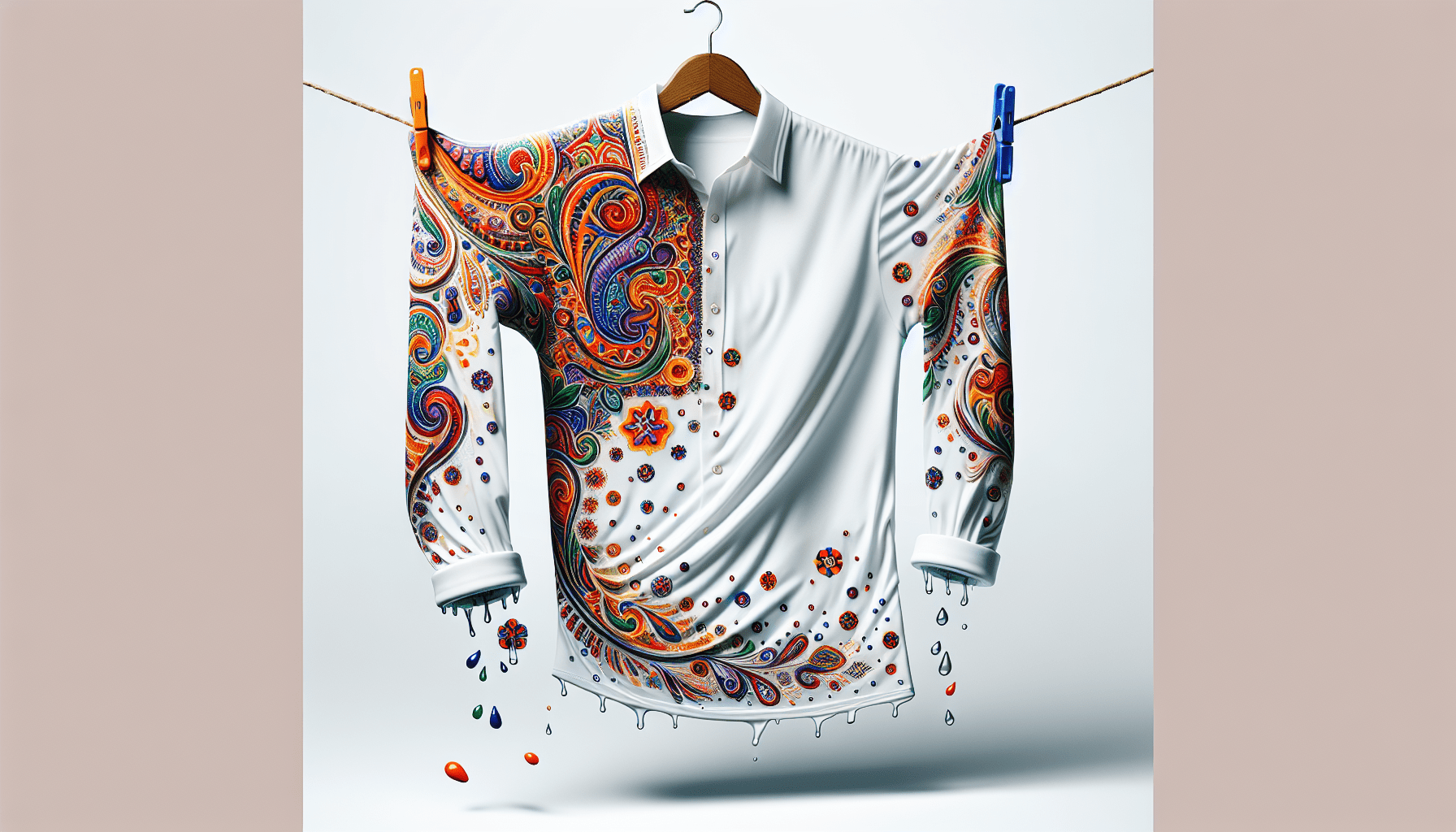Acrylic paint is a versatile medium widely used in the art world, known for its vibrant colors and lasting qualities on various surfaces. However, have you ever wondered if acrylic paint can be used as fabric paint? This article explores the feasibility of using acrylic paint on fabric, delving into the potential risks, benefits, and techniques involved in the process. Whether you’re a seasoned artist or simply looking to add a pop of color to your clothing or textiles, understanding the compatibility and limitations of acrylic paint on fabric is essential for achieving desirable and long-lasting results.

What is Acrylic Paint?
Acrylic paint is a versatile type of paint that is made up of pigment suspended in an acrylic polymer emulsion. It is known for its quick drying time, water-resistance, and vibrant color range. Acrylic paint can be used on various surfaces such as canvas, wood, paper, and even fabric. It is a popular choice among artists and crafters due to its ease of use and accessibility.
Acrylic paint properties and uses
Acrylic paint has several properties that make it suitable for various artistic and creative applications. It has a smooth and creamy consistency, allowing for easy application. It can be diluted with water to achieve a watercolor-like effect or used undiluted for a thicker, bolder finish. Acrylic paint is also known for its excellent color retention and durability, making it ideal for long-lasting artwork.
In terms of uses, acrylic paint is commonly used in traditional painting techniques such as brushwork, palette knife painting, and glazing. It can be applied using various techniques and tools, including brushes, sponges, and even spray bottles. Acrylic paint can also be used in mixed media artwork, collage, and as a base layer for other art mediums.
How acrylic paint differs from other types of paint
Acrylic paint differs from other types of paint, such as oil paint and watercolor, in several ways. One key difference is its fast drying time. Unlike oil paint, which can take days or even weeks to dry, acrylic paint dries quickly, allowing artists to work efficiently and make corrections without much wait time.
Another difference is the medium in which the pigments are suspended. Acrylic paint uses an acrylic polymer emulsion as its binder, while oil paint uses linseed oil. This difference in binder affects the drying time, texture, and overall handling of the paint.
Acrylic paint also differs from watercolor in terms of opacity. While watercolor is transparent and relies on the white of the paper for lightness, acrylic paint can be opaque or transparent depending on the application. This opacity allows for layering and covering mistakes more easily than watercolor.
What is Fabric Paint?
Fabric paint, as the name suggests, is specifically formulated for use on fabric surfaces. It is designed to adhere to fabric fibers and withstand regular wear and washing without fading or cracking. Fabric paint is commonly used for customizing clothing, creating textile art, or transforming plain fabrics into personalized pieces.
Fabric paint properties and uses
Fabric paint has properties that make it suitable for use on fabrics. It is formulated to be flexible, allowing it to move and stretch with the fabric without cracking or peeling. This flexibility ensures that the paint remains intact even after repeated use and washing.
Fabric paint also has excellent color retention and opacity. The vibrancy of the colors remains intact even after washing, making it ideal for creating long-lasting designs on fabric. It can be used on a variety of fabric types, including cotton, linen, silk, and synthetic blends.
In terms of uses, fabric paint can be applied to various fabric-based items such as clothing, tote bags, pillowcases, and even upholstery. It can be used for adding decorative designs, patterns, or even transforming old garments into unique pieces.
How fabric paint differs from other types of paint
Fabric paint differs from other types of paint, including acrylic paint, in terms of its formulation and suitability for fabric surfaces. Fabric paint is specifically designed to bond with fabric fibers and withstand regular washing and wear. This durability is achieved through its specially formulated binder and additives that enhance adhesion and flexibility.
Unlike acrylic paint, fabric paint does not require heat setting or textile medium to adhere to fabric surfaces. It is designed to be used directly on fabric, eliminating the need for additional steps or products. Fabric paint also has a softer feel compared to acrylic paint, allowing it to blend seamlessly with the fabric.
Fabric paint also differs from other fabric decorating methods such as dyeing or printing. While dyeing involves permanently coloring the fabric fibers, fabric paint sits on top of the fabric surface, allowing for more precise designs and detailed artwork. Additionally, fabric paint offers more control over color intensity and allows for layering and blending techniques.
Can Acrylic Paint be Used as Fabric Paint?
The short answer
Yes, acrylic paint can be used as fabric paint. However, there are factors to consider before using acrylic paint on fabric.
Factors to consider
When deciding to use acrylic paint as fabric paint, several factors should be taken into account:
-
Fabric type: Some fabrics may not be suitable for acrylic paint as they may not absorb the paint properly or be compatible with the paint’s binder. Natural fabrics like cotton, linen, and silk generally work well with acrylic paint, while synthetic fabrics may not yield satisfactory results.
-
Fabric usage: Consider how the fabric will be used. If it will undergo frequent washing or heavy wear, acrylic paint may not be the best choice as it is not specifically formulated for fabric durability.
-
Desired effect: Consider the desired effect or finish on the fabric. Acrylic paint can offer a wide range of colors and effects, but it may not have the same softness or flexibility as fabric paint.
-
Personal preference: Ultimately, personal preference plays a role in deciding whether to use acrylic paint as fabric paint. Some artists and crafters prefer the versatility and color range offered by acrylic paint, even if it means sacrificing some fabric-specific properties.
Before using acrylic paint on fabric, it is recommended to test the paint on a small sample piece of fabric to see how it adheres, dries, and withstands washing or wear.
Pros of Using Acrylic Paint as Fabric Paint
Cost-effectiveness
One of the major advantages of using acrylic paint as fabric paint is its cost-effectiveness. Acrylic paint is widely available and generally more affordable compared to fabric-specific paints. This affordability allows artists and crafters to experiment and create without breaking the bank.
Wide color range
Acrylic paint offers a vast color range, with a variety of shades and finishes available. This extensive color selection allows artists to create intricate designs, vibrant patterns, or realistic artwork on fabric. The ability to mix and blend colors also provides endless possibilities for customization.
Availability
Acrylic paint is readily available at most art supply stores, online retailers, and even general stores. It is a popular choice among artists and crafters, making it easily accessible for anyone interested in using it as fabric paint. This availability ensures that artists can find the colors and quantities they need without difficulty.

Cons of Using Acrylic Paint as Fabric Paint
Limited flexibility
Acrylic paint, when used on fabric, may not provide the same level of flexibility and stretch as fabric paint. Fabrics that require flexibility, such as stretchy or tight-fitting garments, may feel stiff or crack when acrylic paint is used. This limitation can affect the overall comfort and wearability of the fabric.
Reduced durability
While acrylic paint is known for its durability on various surfaces, it may not hold up as well on fabric, especially with frequent washing or heavy use. Over time, acrylic paint may crack, fade, or peel from the fabric, leading to a compromised design or artwork. This reduced durability is a significant drawback when compared to dedicated fabric paints.
Potential for cracking or fading
Acrylic paint, particularly when applied thickly, can have a tendency to crack or become brittle on fabric. It is important to apply thin layers of paint and allow them to dry thoroughly to minimize the risk of cracking. Additionally, certain colors may have a higher chance of fading or changing over time, especially when exposed to sunlight or harsh washing conditions.
Preparation and Application of Acrylic Paint on Fabric
Choosing the right fabric
Before applying acrylic paint on fabric, it is important to choose a fabric that is suitable for this type of paint. Natural fabrics such as cotton, linen, and silk tend to work well with acrylic paint, as they readily absorb and hold the paint. Synthetic fabrics like polyester may not yield satisfactory results, as the paint may not adhere properly or become stiff.
Preparing the fabric
To ensure the best results, fabric should be properly prepared before applying acrylic paint. It is recommended to wash and dry the fabric prior to painting to remove any sizing, dirt, or chemical finishes. This will help the paint adhere better to the fabric surface and prevent any unwanted reactions.
Mixing acrylic paint for fabric use
Acrylic paint can be mixed with a fabric medium or textile medium to enhance its adhesion and flexibility on fabric. Fabric medium is designed to be mixed with acrylic paint to make it more suitable for fabric applications. Follow the manufacturer’s instructions for proper mixing ratios or usage recommendations.
Application techniques
Acrylic paint can be applied to fabric using various techniques. Brushes, sponges, palette knives, or even airbrushing can be used to achieve different textures and effects. It is important to apply thin, even layers of paint, allowing each layer to dry completely before applying additional layers or colors. This will help prevent cracking or stiffness in the finished design.
Fixing Acrylic Paint on Fabric
Heat setting
To ensure the paint adheres properly to the fabric and withstands washing, heat setting may be required. Heat setting involves applying heat, usually with an iron, to the painted fabric. Follow the manufacturer’s instructions for the specific acrylic paint used, as different brands may have different heat setting requirements.
Air drying
If heat setting is not necessary or recommended for the acrylic paint used, air drying the painted fabric is an alternative method. Simply let the fabric air dry for the recommended drying time specified by the paint manufacturer. It is important to avoid any contact or friction on the painted surface until the paint is completely dry to prevent smudging or smearing.
Ironing
Ironing can be used as a heat setting method for acrylic paint on fabric. Place a thin cloth or parchment paper over the painted fabric and set the iron to the appropriate temperature for the fabric type. Gently iron over the cloth or paper for a few minutes, ensuring even heat distribution and pressure. This will help bond the paint to the fabric fibers.
Using textile medium
As mentioned earlier, mixing acrylic paint with a fabric or textile medium can enhance its adhesion and flexibility on fabric. Using a fabric medium ensures the paint remains soft and pliable, even after it dries. Follow the manufacturer’s instructions for proper usage and mixing ratios when using a textile medium.
Tips for Achieving Best Results with Acrylic Paint on Fabric
Thinning acrylic paint
For a watercolor-like effect or lighter coverage on fabric, acrylic paint can be thinned with water. Gradually add small amounts of water to the paint until the desired consistency is achieved. It is important to note that additional layers may be needed to achieve vibrant colors when thinning acrylic paint.
Layering and blending
Acrylic paint allows for layering and blending techniques on fabric. By applying multiple thin layers of paint and allowing each layer to dry before adding the next, artists can create depth and dimension in their designs. Additionally, wet-on-wet blending techniques can be used to seamlessly mix colors and create smooth transitions.
Setting paint before washing
To ensure longevity, it is recommended to let the painted fabric set for at least 24 to 48 hours before washing. This allows the paint to fully cure and bond with the fabric fibers. Avoid washing the fabric during this curing period to prevent any damage or interference with the paint.
Proper fabric care
When using acrylic paint on fabric, it is important to follow proper fabric care instructions. Washing the fabric inside out on a gentle cycle with mild detergent can help preserve the painted design. Avoid harsh detergents, bleach, or any other chemicals that may fade or damage the paint. Additionally, air drying or tumble drying on a low heat setting is recommended to prevent unnecessary wear on the painted fabric.
Testing on a sample fabric
Before painting on a larger or more important fabric piece, it is always a good idea to test the acrylic paint on a sample fabric. This allows artists to assess how the paint adheres, dries, and withstands washing or wear. It also provides an opportunity to experiment with different techniques or color combinations to achieve the desired result.
Alternative Fabrics for Acrylic Paint
Acrylic paint can be used on various fabric types, but certain fabrics may yield better results than others. Here are some alternative fabrics that work well with acrylic paint:
Canvas
Canvas is a commonly used fabric for acrylic paint due to its durability and texture. It provides a sturdy surface that can handle the heavy impasto techniques often associated with acrylic painting. Canvas is commonly used for creating art pieces, wall hangings, or stretched canvases for painting.
Denim
Denim is another fabric that pairs well with acrylic paint. The thick and durable nature of denim allows the paint to adhere and withstand regular wear. Denim garments, tote bags, or jackets can be personalized with acrylic paint to create unique and fashionable designs.
Polyester blends
While acrylic paint may not adhere as well to pure synthetic fabrics like polyester, it can work well on polyester blends. Fabrics that contain a blend of natural fibers such as cotton or silk with polyester can provide a good surface for the paint to bond with. Be sure to test on a sample fabric to ensure satisfactory results.
Synthetic fabrics
While acrylic paint may not be the ideal choice for all synthetic fabrics, it can still be used on certain types such as nylon and rayon. Similar to polyester blends, fabrics that contain a blend of natural and synthetic fibers can provide a good surface for acrylic paint. Always test on a small sample before painting on a larger fabric piece.
Other textiles
In addition to the mentioned fabrics, there are various other textiles and fabric surfaces that can be painted with acrylic paint. This includes burlap, muslin, felt, and even leather or faux leather. As always, testing on a small sample fabric is recommended to ensure the desired results.
Additional Options for Fabric Painting
Ready-made fabric paints
For those who prefer dedicated fabric paints, there are many ready-made options available in the market. Fabric paints are specifically formulated for fabric surfaces, offering enhanced durability, flexibility, and color options. These ready-made fabric paints often come in easy-to-use bottles or tubes, making them convenient for various fabric painting projects.
Fabric markers
Fabric markers are another option for creating designs on fabric. These markers are similar to regular markers but are specially formulated to work on fabric surfaces. Fabric markers offer precise control, making them ideal for detailed designs or adding finishing touches to painted fabric.
Textile spray paints
Textile spray paints provide another creative option for fabric painting. They come in aerosol cans and allow for easy application, including stenciling or creating unique textures. Textile spray paints can provide a quick and even coverage on fabric, making them suitable for larger projects or when a more uniform finish is desired.
Dyeing methods
Dyeing fabric is another method of coloring fabric that differs from traditional painting techniques. Fabric dyes are specifically designed to permanently color the fabric fibers, resulting in a more integrated and long-lasting finish. Dyeing methods such as tie-dye, batik, or Shibori can create vibrant and unique designs on fabric.
In conclusion, while acrylic paint can be used as fabric paint, there are factors to consider before using it on fabric. Acrylic paint offers cost-effectiveness, a wide color range, and availability, but it also has limitations in flexibility, durability, and potential for cracking or fading on fabric. Proper preparation, application techniques, and fixing methods can help achieve the best results with acrylic paint on fabric. Additionally, alternative fabrics and other options such as ready-made fabric paints, fabric markers, textile spray paints, and dyeing methods provide alternatives for fabric painting projects.



